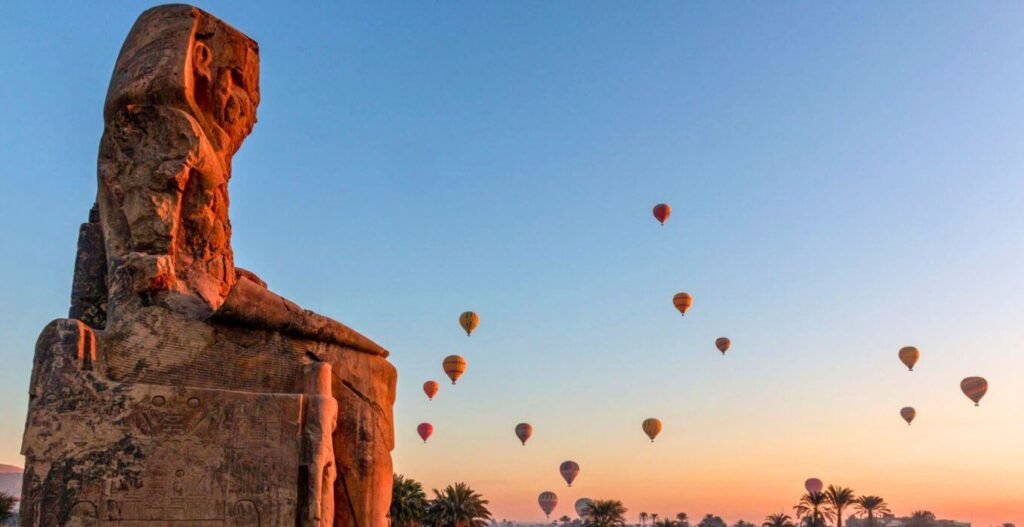The Colossi of Memnon are two colossal stone statues situated on the west bank of the Nile, facing Luxor. For ages, these statues stood sentinel, gazing eastward towards the rising sun, overlooking the tranquil flow of the Nile.
Visible from the East Bank, these statues, standing at 59 feet, have been famous for centuries due to a mysterious sound emitted from one of them at sunset.
According to poetic legend, the name “Memnon” is associated with the singing voice of Eos, the Greek goddess of dawn and the mother of Memnon. As the code goes, Eos wept dew-like tears daily because her son, Memnon, met his fate at the hands of Achilles during the Trojan War.
In Greek mythology, Memnon is depicted as the son of Tithonus, a Troy prince, and the dawn goddess, Eos. He reigned as the king of Persia and Ethiopia, allying himself with the Trojans during the concluding year of the Trojan War.
Egypt Nile Cruises offers a trip you will never forget, where history and luxury unite smoothly. If you want to experience the beauty of Luxor, you can take a boat ride to see Luxor attractions along the Nile. Learn about the mysterious beauty of the Nile River, which is lined with cultural gems and old wonders.
Description of Colossi of Memnon in Egypt
The Colossi of Memnon stands at a towering height of 18 meters, each weighing 720 tons, sculpted from individual sandstone blocks. These two majestic statues portray a royal figure seated upon an intricately designed throne, depicting the pharaoh adorned with the distinguished royal headdress, the Nemes. The divine cobra symbolically protects the king, displayed prominently on the royal brow.
With their hands resting on their knees, the statues face eastward, their gaze directed towards the Nile, symbolizing a significant alignment with the river’s flow. In front of the sculptures are smaller figures representing the pharaoh’s wife, Tiye, and mother, Mutemwiy.
Though slightly damaged over time, these statues remain enduring symbols of the profound Egyptian civilization and cultural heritage, speaking volumes about the grandeur and legacy of ancient Egypt.

Who is Memnon?
Memnon, a legendary figure from Greek mythology, was renowned as the Ethiopian king and a brave hero during the Trojan War. Leading his armies from Africa to Asia in defense of the besieged city, his fate was sealed in battle against Achilles, resulting in his demise.
The two colossal statues, commonly known as the Colossi of Memnon, are often associated with the broader Theban cemetery, referred to as the “Memnonium.” This name has endured for over two millennia, preserving the legacy and recognition of these monumental statues within ancient Egypt’s historical and cultural context.
As you can see in the statue of Memnon.
- Two double statues show Amenhotep sitting.
- Two other Minifigures represent Amenhotep’s wife, Tiye, and Amenhotep’s mother, Mutmuya.
Colossi of Memnon Facts
The Colossi of Memnon, situated on Luxor’s West Bank along the Nile, were affected by an earthquake in 27 B.C., destroying part of one of the statues. The upper section collapsed, leaving the bottom half with visible cracks. Following this event, an intriguing phenomenon occurred: peculiar sounds emanated from the bottom half of the statue. It’s believed that these sounds were generated when air currents interacted with the porous surface of the sun-warmed stones.
As the temperature rose, causing the accumulated dew to evaporate overnight, it produced a reverberating sound akin to a “melody.” However, despite this explanation, the true cause of the sound remains unverified. The phenomenon ceased after a restoration process that took place many centuries ago, and since then, the enigmatic music has stopped being heard.

Talking Colossi of Memnon
The allure of the Colossi of Memnon, generating mystical melodies, captivated travelers from ancient Greece and Rome for generations. The renowned Greek historian and geographer Strabo was among the first to document this phenomenon during his travels around 20 B.C.
Other prominent figures from Greek and Roman cultures, such as Pausanias, Tacitus, and Juvenal, also chronicled this fascinating occurrence. Numerous travelers, including notable emperors, ventured to witness this extraordinary sight. Emperor Septimius Severus, around 199 A.D., conducted repairs on the statue, after which the melodic phenomenon ceased.
These colossal statues, often linked to the god Memnon due to the sounds they produced, were attributed to depicting Amenhotep III, an ancient Egyptian ruler who reigned approximately 3,400 years ago alongside his wife, Tiye. Positioned at the entrance of an expansive temple complex, some believed this complex rivaled the grandeur of Karnak temple in size.
The statues portray Amenhotep III and Tiye seated eastward toward the Nile, a customary depiction during the New Kingdom, symbolizing the pharaoh’s divinity. Amenhotep III commissioned this entrance, where the colossal figures of Memnon once stood. Spanning 35 hectares, Amenhotep’s temple complex held immense significance and wealth, surpassing the luxury of renowned kings like Ramesses II and Ramesses III in ancient Egypt.
Recomposed two colossal statues of Pharaoh Amenhotep III
Amenhotep III’s reign during the New Kingdom era marked a pinnacle in Ancient Egypt’s history, renowned for his exceptional skills as a builder. Among his significant constructions, the temple that stood as his most important achievement, though now reduced to scant ruins, attests to his architectural prowess.
Unfortunately, the temple faced rapid deterioration due to ongoing looting activities, diminishing its structure significantly. Positioned in a floodplain of the Nile, an unfavorable location for preservation, the temple suffered substantial erosion from annual flooding. The limestone used in its construction deteriorated over centuries due to the continuous impact of the Nile’s floods, contributing to the temple’s near-obliteration, leaving behind only remnants and the iconic Colossi.
Historical records suggest that the extensive complex might have been subject to intrusions even during the time of the Pharaohs. Some theories propose that portions of the temple’s stone blocks were repurposed for constructing other edifices. Despite this widespread pilfering, the two monumental statues, the Colossi, stood alone, yet they also combed to a deplorable state of preservation over time.

